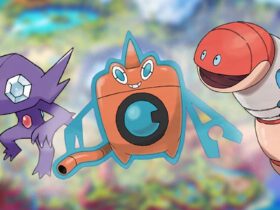Tucked away in the southern part of Johto lies one of the Pokémon world’s most cryptic and ancient locations: the Ruins of Alph. First introduced in Pokémon Gold, Silver, and Crystal, these mysterious chambers immediately stood out with their eerie silence, puzzle-filled interiors, and the sudden appearance of Unown—Pokémon shaped like letters of an ancient script.
But beyond the gameplay mechanics, one question continues to puzzle fans:
Who built the Ruins of Alph—and why?
In this blog, we explore the origins, theories, and secrets surrounding this enigmatic site.
What Are the Ruins of Alph?
Located west of Violet City and south of Route 36, the Ruins of Alph appear to be an ancient archaeological site composed of:
- Four puzzle chambers
- Multiple sealed doors and secret rooms
- Ancient murals and inscriptions
- The first known encounter with the Unown, a mysterious Pokémon species
As you solve puzzles, Unown begin to appear in the ruins, suggesting a link between these letter-shaped Pokémon and the civilization that once inhabited—or worshipped—the ruins.
In-Game Lore and Clues


The games provide subtle but significant lore hints:
- Pokémon Gold/Silver (and their remakes) mention that the ruins are under study by scientists and archaeologists from the nearby Research Center.
- Ancient texts uncovered within the ruins mention that “a thousand years in the past, people and Pokémon lived in harmony here.”
- In HeartGold and SoulSilver, completing puzzles reveals hidden messages written in Unown text, which include phrases like: “OUR CLAN CREATED POKÉMON STATUE OUTSIDE.” “ESCAPE,” “FRIEND,” “LIFE,” “HUMAN” — each word hinting at the creators’ values or beliefs.
These clues point to a lost clan or civilization with advanced knowledge of both architecture and language—suggesting they weren’t primitive, but deeply spiritual or symbolic in nature.
Who Were the Builders? The Leading Theories
Though no official source names the creators of the Ruins of Alph, fans and lore analysts have formed multiple compelling theories:
A. The Alphans – A Lost Johto Civilization
The most widely accepted theory is that the Ruins of Alph were built by an ancient people native to Johto—commonly referred to as the Alphans. These people likely:
- Worshipped or coexisted with Unown
- Developed a form of proto-writing, inspiring the Unown alphabet
- Built the ruins as a temple, communication center, or dimensional gate
The Alphans may have disappeared or merged with modern Johto culture, but their legacy remains etched in the ruins’ design and messages.
B. The Creators of Unown – A Symbiotic Origin
Another theory suggests that the Unown themselves either created the ruins or guided the humans who did. Supporting points include:
- Unown are drawn to psychic energy and symbols.
- In Pokémon 3: Spell of the Unown, they’re shown as interdimensional beings capable of warping reality when concentrated.
- The appearance of Unown after solving puzzles implies they’re sealed within or respond to specific patterns.
This gives rise to the idea that the Ruins were either:
- A prison to contain Unown
- A beacon or dimensional doorway to attract them
- A communication hub where humans and Unown exchanged knowledge
C. Ties to Sinnoh’s Celestica People
Some fans connect the Alphans with the Celestica people from Pokémon Legends: Arceus, an ancient group in Sinnoh who worshipped Arceus and the Legendary Pokémon. This theory suggests:
- Ancient cultures across regions were connected by a common spiritual belief system
- The Unown language might predate written language and was shared across ancient societies
- The ruins in Johto (Alph) and Sinnoh (Solaceon Ruins) share architectural similarities
While speculative, the growing lore from games like Legends: Arceus strengthens the idea of an interconnected ancient world.
Purpose of the Ruins: What Were They For?
Despite the unanswered questions, the design and secrets of the Ruins offer clues to their purpose:
A. A Shrine to the Unown
Given the Unown’s dominance in the ruins, the site could have been a temple or sanctuary, where the Alphans worshipped or studied these beings. The puzzles might have served as rituals to summon or interact with them.
B. A Communication Device
Unown resemble letters of the Latin alphabet, and their arrangement in the ruins implies that the builders may have used them to record messages or commune across dimensions.
C. A Dimensional Seal or Gateway
Some believe the ruins are a gateway to the Unown’s dimension, or a barrier meant to keep their power from leaking into the world. This aligns with their reality-warping abilities shown in the Pokémon 3 movie.
Ruins Beyond Alph: A Broader Pattern
The Ruins of Alph aren’t alone. Similar sites exist across the Pokémon world:
- Solaceon Ruins (Sinnoh) – Also filled with Unown and ancient carvings.
- Tanoby Ruins (Sevii Islands) – Where solving puzzles releases Unown into the wild.
- Sinjoh Ruins (HeartGold/SoulSilver) – A mysterious temple blending Sinnoh and Johto elements, accessible only through special events.
These sites support the theory that the Pokémon world was once populated by ancient civilizations deeply connected to Pokémon, language, and the unknown.
Conclusion
The Ruins of Alph are one of the Pokémon franchise’s most haunting and mysterious locations. While we may never get a definitive answer as to who built them, their design, lore, and connection to the Unown suggest:
- An ancient, possibly highly intelligent clan once lived in Johto
- They may have had direct contact with interdimensional Pokémon
- Their culture valued language, ritual, and the mysteries of the unknown
Like the pyramids or Stonehenge in our own world, the Ruins of Alph continue to capture the imagination of fans and researchers alike—a silent monument to a time when Pokémon and people were perhaps more spiritually intertwined than we ever realized.
What’s your favorite theory about the Ruins of Alph? Share your thoughts and interpretations in the comments below!















Leave a Reply